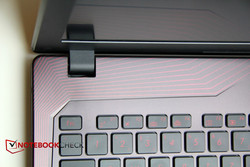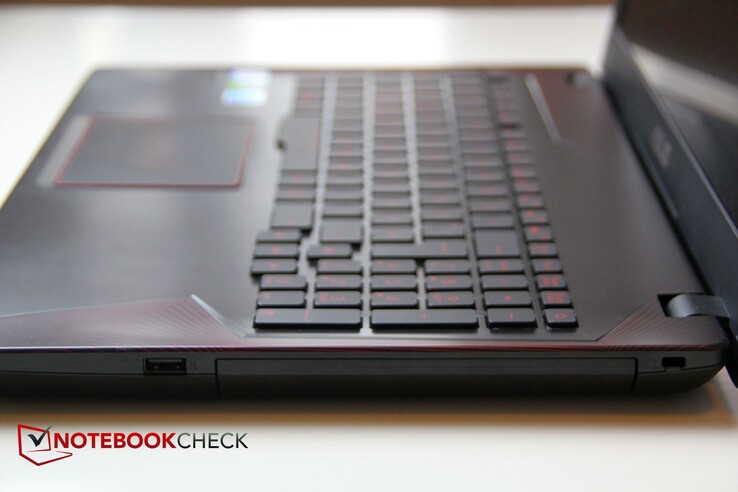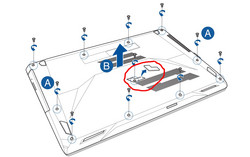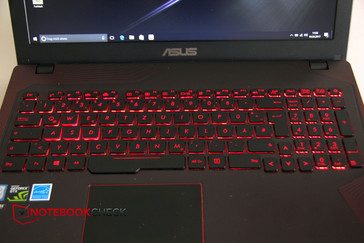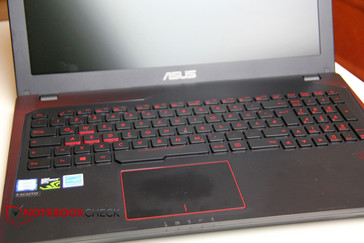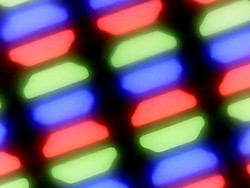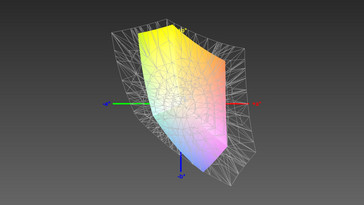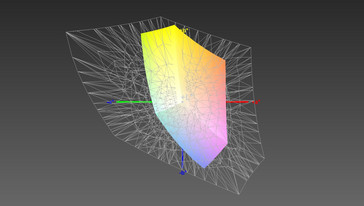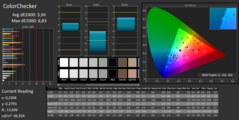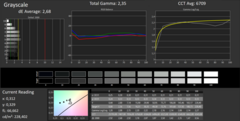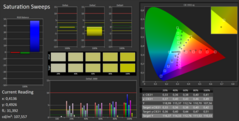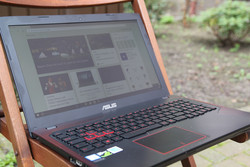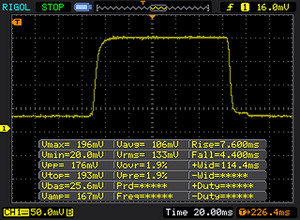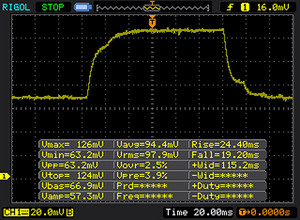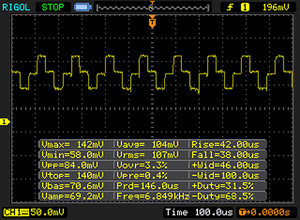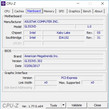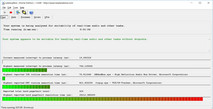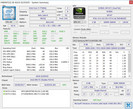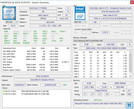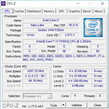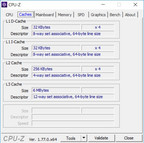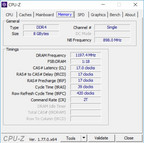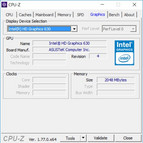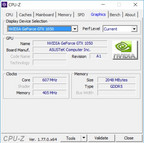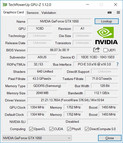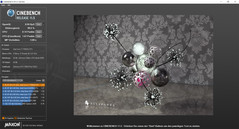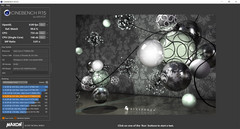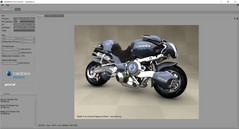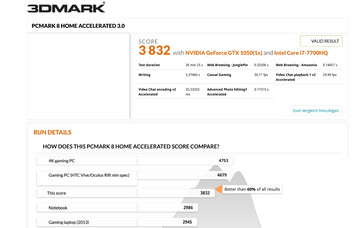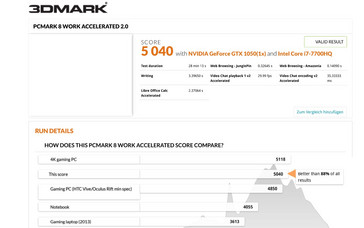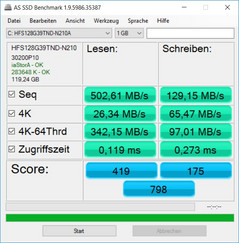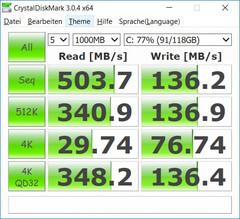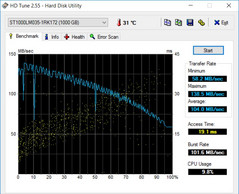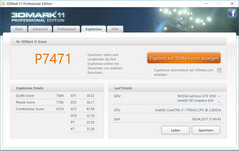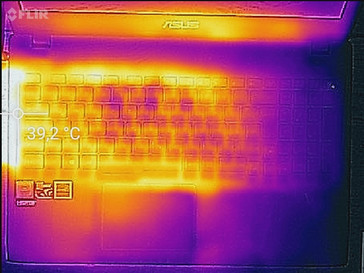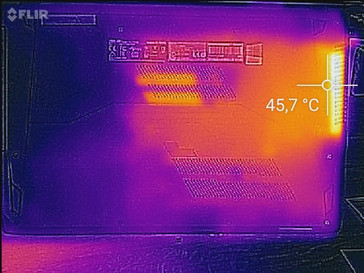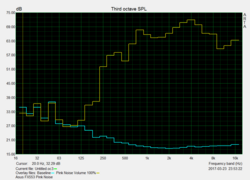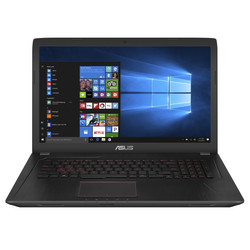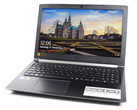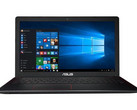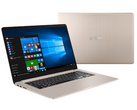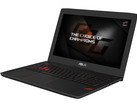Asus FX553VD (7700HQ, GTX 1050) Laptop Review

For the original German review, see here.
Multimedia or even gaming notebook? The FX553VD represents Asus' entry-level model with a dedicated Pascal graphics card. It is supposed to assure multimedia and gaming suitability and be gentle on the gamer's wallet at the same time. We compare it with an Asus in-house competitor, the FX502 model with GTX 1060, as well as similarly equipped competitors such as the HP Pavilion 15, the Acer Aspire VX5-591G, the Dell Inspiron 15 7000 7567, and the MSI GL62M. Our test unit can be purchased from around 1100 Euros (~$1177), and one equipped with an i5 instead of i7 it costs only around 900 Euros (~$963).
Case
The case is made exclusively of plastic and shows some design peculiarities on the top. The basic black design is ornamented by diagonal, thin, red lines. This gives the notebook an individualistic look and underlines its gaming ambitions. The contrasting dark red can be noticed all through the unit, also when the lid is open. Although the display frame is kept in black, the black keys present red lettering, the touchpad has a red frame, and the base plate is also lightly colored in dark red. Unfortunately the beautiful lacquer magically attracts fingerprints and gets smudged easily.
The solid hinges offer good stability, though at a pinch, the FX553 can be opened also with one hand. Compared to its FX502 sibling, the lid with the screen is even more flexible. A slight pressure on the closed lid leaves a very spongy impression. The plastic of the hand rest and under the keyboard gives in minimally, which, however, unlike the lid, remains within normal range. As in the review of the FX502, some isolated minimal gaps are also apparent between the display and inner frame. Overall, the top of the case cannot be called particularly stable. The bottom offers a better impression, nothing wobbles or creaks. On the left side is the air vent, which is also framed in red.
In terms of size and weight, the FX553VD falls between its competitors: only the HP Pavilion 15 is 100 grams (~3.5 oz) lighter, the MSI GL62M has a similar weight, and most other competitors are up to 400 grams (~0.9 lb) heavier. It appears minimally thicker than the competitors, but this might be due to our having measured at the thickest section in front (speakers), and the notebook tapers down towards the back. In terms of its dimensions, it is about the same as the MSI, most of the other devices are slightly deeper or even wider. For an entry-level gaming laptop, the Asus FX553 lies in the lower midfield in terms of its weight and size.
Features
The connections of the FX553VD are unremarkable: the back has none, in the front is the card reader in the center. The right side is equipped with only an optional optical drive or dummy of it, a USB 2.0 port, and the slot for a lock. All the other ports are on the left side, which include a LAN and an HDMI port, three USB 3 ports (one of them Type-C without Thunderbolt), and unfortunately just a combined headphone and microphone port. Because there is also a wide air vent besides the power port on the same side, the ports are very close together, which may cause some frustrations with thick cables or larger USB devices. In the meantime, the other devices have more success here. Since all of the important connections are on the left side in front where they will be in the way when using a left-handed mouse, left-handed users will find themselves in even more trouble.
In the specifications, the Asus website also advertises a DVD multi-function drive. Our test unit has no such drive, however. Although we can see a slot for a drive on the right side, this apparently dummy cannot be opened, nor does it appear as a drive in Explorer. So obviously there must be notebook versions with and without the DVD burner.
SD Card Reader
In the JPEG copy test with our reference Toshiba Exceria Pro SDXC 64 GB UHS-II memory card, the internal card reader reaches a speed of just over 80 MB/s and with this falls into the unremarkable middle of the field. For a 1 GB image file, the device needs about 13 seconds. These values are already known from its sibling, the FX502. However, the test model offers a spring mechanism that latches the card in place without it protruding.
| SD Card Reader | |
| average JPG Copy Test (av. of 3 runs) | |
| Asus FX553VD-DM249T | |
| Asus FX502VM-AS73 | |
| HP Pavilion 15t-X7P42AV | |
| MSI GL62M 7RD-077 | |
| Acer Aspire VX5-591G-75C4 VX15 | |
| Dell Inspiron 15 7000 7567 | |
| maximum AS SSD Seq Read Test (1GB) | |
| HP Pavilion 15t-X7P42AV | |
| Asus FX553VD-DM249T | |
| Asus FX502VM-AS73 | |
| MSI GL62M 7RD-077 | |
| Acer Aspire VX5-591G-75C4 VX15 | |
| Dell Inspiron 15 7000 7567 | |
Communication
The Asus FX553 is equipped with a Realtek GBit LAN adapter, and the Wi-Fi adapter comes from Intel and supports all the current standards including the fast ac standards. Compared to the competitors, it positions itself in the middle or upper range in our transfer test. In the send performance in particular, the notebook performs stronger than some of the more expensive competitors.
| Networking | |
| iperf3 transmit AX12 | |
| Asus FX553VD-DM249T | |
| Acer Aspire VX5-591G-75C4 VX15 | |
| HP Pavilion 15t-X7P42AV | |
| Asus FX502VM-AS73 | |
| MSI GL62M 7RD-077 (jseb) | |
| Dell Inspiron 15 7000 7567 (jseb) | |
| iperf3 receive AX12 | |
| HP Pavilion 15t-X7P42AV | |
| Asus FX502VM-AS73 | |
| Acer Aspire VX5-591G-75C4 VX15 | |
| Asus FX553VD-DM249T | |
| MSI GL62M 7RD-077 (jseb) | |
| Dell Inspiron 15 7000 7567 (jseb) | |
Accessories
No positive surprise in the accessories: other than the power supply, the warranty booklet, and quick instructions, there is nothing else in the box.
Maintenance
Unfortunately, the battery of the device cannot be removed or exchanged easily. Nor does the computer offer a maintenance hatch. According to the manual, you can loosen 11 screws with a mini Phillips screwdriver and then take off the bottom of the case to get access to the hardware. This proved very difficult in practice, however. First, the central screw is placed underneath one of the rubber feet, which seems to be glued on, so it cannot be attached back easily afterwards. Also, after all the screws were loosened, the bottom of the case still did not budge, so that for the sake of the device, we finally gave up our attempts. For the inexperienced user, this will be a great obstacle. At least, in theory however, you could upgrade the battery, memory, SSD, and HDD in this way.
Warranty
For customers in Germany and Austria, the manufacturer Asus offers a 2-year Collect & Return warranty. For around 70 Euros (~$75), some shops allow increasing the warranty for a further two years. Please see our Guarantees, Return policies and Warranties FAQ for country-specific information.
Input Devices
Keyboard
The red design theme continues also on the keyboard: a red illumination can be adjusted in three steps of brightness or turned off completely. The lettering is also red instead of the usual white. The layout does not step out of line, but offers some especial features. As in the ROG gaming series, the WASD keys are emphasized again with a reddish frame, the input key is slightly smaller, and the arrow keys are offset towards the bottom and reach a little into the number pad on the right.
The keystroke is quite firm and not spongy at all, the keys do not wobble or creak, only the bottom of the keyboard gives in slightly under pressure. The stroke is 1.6 mm (~0.06 in), and the key noise is not too loud. The placement of the power button is rather unusual. Designed like another key, it is placed in the top right corner. While this still led to some confusion with the PgDn or End keys in the FX502, it has been corrected in the FX553 through a changed layout. The less-often used Print key is now directly next to the Power key, so that an accidental press becomes more unlikely. However, we still ended up cursing sometimes, when in our practice test we accidentally pressed the Power key out of habit, instead of the End key, and so put the device to sleep without wanting to. Therefore, we would really prefer a separate power button that is offset from the rest of the keyboard.
Touchpad
The 10.5 x 7.5 cm (~4.3 x 2.9 in) touchpad has been adopted from the FX502 and therefore in all likelihood it has inherited all its advantages and disadvantages: It offers good gliding characteristics in all zones, but quickly attracts fingerprints due to its surface structure. The clicking area at the bottom is not noticeably separated, and the low sensitivity leads to unintended clicking. But you get used to applying less pressure. The mouse-replacement offers many control gestures, it recognizes up to four-finger gestures, which also worked well in our test.
Display
In the display, the differences between the more affordable FX and the more expensive GL series can be noticed. Unlike the IPS display of the expensive Asus GL502, the FX553 comes with a non-reflective BEO TN panel like the one in FX502. It offers a 1920x1080 pixel Full HD resolution, but as expected, otherwise cannot keep up with the more expensive model in terms of contrast, brightness, and color reproduction. On the other hand, the measured values are not particularly untypical for affordable TN panels.
The low brightness value of only 215 cd/m² in particular, leads us to assume that it is not very suitable for outdoors. The contrast of 489:1 also remains far behind the IPS panel of the HP Pavilion 15, for example, although it has even increased compared to the FX502. We cannot complain much about the brightness distribution, since it is well-balanced. Especially positive: we did not notice any screen bleeding at all in our test unit.
| |||||||||||||||||||||||||
Brightness Distribution: 91 %
Center on Battery: 227 cd/m²
Contrast: 489:1 (Black: 0.46 cd/m²)
ΔE ColorChecker Calman: 3.94 | ∀{0.5-29.43 Ø4.78}
ΔE Greyscale Calman: 2.68 | ∀{0.09-98 Ø5}
57% sRGB (Argyll 1.6.3 3D)
36% AdobeRGB 1998 (Argyll 1.6.3 3D)
39.24% AdobeRGB 1998 (Argyll 3D)
57.1% sRGB (Argyll 3D)
37.98% Display P3 (Argyll 3D)
Gamma: 2.35
CCT: 6709 K
| Asus FX553VD-DM249T BOE, , 1920x1080, 15.6" | MSI GL62M 7RD-077 Chi Mei N156HGE-EAL, , 1920x1080, 15.6" | HP Pavilion 15t-X7P42AV AU Optronics AUO41ED, , 1920x1080, 15.6" | Acer Aspire VX5-591G-75C4 VX15 LG Philips LGD0550 / LP156WF6-SPK4, , 1920x1080, 15.6" | Dell Inspiron 15 7000 7567 AU Optronics AUO38ED B156HTN 28H80, , 1920x1080, 15.6" | Asus FX502VM-AS73 1920x1080, 15.6" | |
|---|---|---|---|---|---|---|
| Display | 105% | -0% | 2% | -4% | 1% | |
| Display P3 Coverage (%) | 37.98 | 85.4 125% | 38.03 0% | 38.88 2% | 36.42 -4% | 38.28 1% |
| sRGB Coverage (%) | 57.1 | 100 75% | 56.5 -1% | 58.2 2% | 54.9 -4% | 56.9 0% |
| AdobeRGB 1998 Coverage (%) | 39.24 | 83.8 114% | 39.29 0% | 40.2 2% | 37.62 -4% | 39.47 1% |
| Response Times | -83% | -75% | -30% | -106% | -35% | |
| Response Time Grey 50% / Grey 80% * (ms) | 43 ? | 44 ? -2% | 44.4 ? -3% | 22 ? 49% | 36 ? 16% | 28.4 ? 34% |
| Response Time Black / White * (ms) | 11 ? | 29 ? -164% | 27.2 ? -147% | 23 ? -109% | 36 ? -227% | 22.4 ? -104% |
| PWM Frequency (Hz) | 198 ? | |||||
| Screen | -42% | -37% | 2% | -72% | -27% | |
| Brightness middle (cd/m²) | 225 | 258 15% | 209.7 -7% | 281 25% | 246 9% | 209.5 -7% |
| Brightness (cd/m²) | 215 | 234 9% | 193 -10% | 257 20% | 235 9% | 205 -5% |
| Brightness Distribution (%) | 91 | 79 -13% | 75 -18% | 85 -7% | 75 -18% | 92 1% |
| Black Level * (cd/m²) | 0.46 | 0.54 -17% | 0.19 59% | 0.32 30% | 0.55 -20% | 0.69 -50% |
| Contrast (:1) | 489 | 478 -2% | 1104 126% | 878 80% | 447 -9% | 304 -38% |
| Colorchecker dE 2000 * | 3.94 | 9.74 -147% | 7.8 -98% | 5.16 -31% | 10.97 -178% | 4.7 -19% |
| Colorchecker dE 2000 max. * | 6.83 | 14.6 -114% | 24.1 -253% | 9.09 -33% | 19.7 -188% | |
| Greyscale dE 2000 * | 2.68 | 11.59 -332% | 7.3 -172% | 4.57 -71% | 14.25 -432% | 1.8 33% |
| Gamma | 2.35 94% | 2.19 100% | 2.39 92% | 2.59 85% | 1.83 120% | 2.23 99% |
| CCT | 6709 97% | 11851 55% | 5771 113% | 6931 94% | 11200 58% | 6975 93% |
| Color Space (Percent of AdobeRGB 1998) (%) | 36 | 76 111% | 39.3 9% | 37 3% | 35 -3% | 36.2 1% |
| Color Space (Percent of sRGB) (%) | 57 | 100 75% | 56.5 -1% | 58 2% | 55 -4% | 56.6 -1% |
| Total Average (Program / Settings) | -7% /
-18% | -37% /
-34% | -9% /
-2% | -61% /
-62% | -20% /
-23% |
* ... smaller is better
Although the black value is not that exciting, the competitors from MSI and Dell do not turn out any better. Acer and HP are ahead here. At 57% and 36%, respectively, the sRGB and AdobeRGB color space coverage is also extremely bad, although all the competitors line up there as well. The only device faring clearly better in this regard is the MSI model (100% and 76%). Thus the FX553 is not suitable for enthusiastic hobby photographers and much less for those who do professional image processing, but this is also not the targeted audience. The occasional gamer will rather appreciate the quick response time.
In spite of its mixed results, subjectively the screen does not make such a bad impression - at least not indoors. We could not see it negatively affecting office applications or games much, which is probably due to the good brightness distribution. The display appears fairly neutral, only the colors could be more vivid.
Display Response Times
| ↔ Response Time Black to White | ||
|---|---|---|
| 11 ms ... rise ↗ and fall ↘ combined | ↗ 7 ms rise | |
| ↘ 4 ms fall | ||
| The screen shows good response rates in our tests, but may be too slow for competitive gamers. In comparison, all tested devices range from 0.1 (minimum) to 240 (maximum) ms. » 28 % of all devices are better. This means that the measured response time is better than the average of all tested devices (20.2 ms). | ||
| ↔ Response Time 50% Grey to 80% Grey | ||
| 43 ms ... rise ↗ and fall ↘ combined | ↗ 24 ms rise | |
| ↘ 19 ms fall | ||
| The screen shows slow response rates in our tests and will be unsatisfactory for gamers. In comparison, all tested devices range from 0.165 (minimum) to 636 (maximum) ms. » 70 % of all devices are better. This means that the measured response time is worse than the average of all tested devices (31.6 ms). | ||
Screen Flickering / PWM (Pulse-Width Modulation)
| Screen flickering / PWM not detected | ≤ 90 % brightness setting | ||
In comparison: 53 % of all tested devices do not use PWM to dim the display. If PWM was detected, an average of 8108 (minimum: 5 - maximum: 343500) Hz was measured. | |||
On their website, Asus advertises the extremely stable viewing angle of the display, the strong contrast, and colors that do not fade even viewed from extreme angles. For the actual TN panel, this is nonsense, of course. According to our measurements, it is neither particularly bright, nor does it have a high contrast. In fact, when looking from 45-degree side angles, the color deviations are within limits and the contents of the screen are still quite recognizable. The greatest deviation can be seen when looking from the bottom; here the image appears very dark. But looking from the sides, we can verify the TN display's stable viewing angles.
Performance
Our Asus FX553VD test unit is equipped with a Core-i7-7700HQ and 8 GB of RAM. Optionally, the laptop is also available with a slightly weaker processor, the Core-i5-7300HQ. This can be accompanied by 32 GB of RAM. The test unit comes with one 8 GB of RAM, a second slot remains unoccupied. Currently, 8 GB is standard in this price range and 16 GB is usually only built into the more expensive models. The 8 GB together with the mobile GeForce GTX 1050 should prove sufficient for gaming. It should be mentioned, that Asus uses a model with only 2 GB of dedicated memory as the graphics card, the GTX 1050 is also available with twice the storage. Particularly at higher resolutions and maximum settings, this could become noticeable. The MSI Pendant is also equipped with only 2 GB while Acer, HP, and Dell provide their notebooks with the 4 GB graphics variant.
Processor
The Core-i7-7700HQ is based on the current Kaby Lake architecture and belongs to the 7thgeneration of Intel's mobile Core-i models. It has a 45-watt TDP and is one of the faster mobile CPUs. The clock speed is quite variable; the basic clock speed is 2800 MHz and can be increased to a maximum of 3800 MHz turbo speed. All the comparison models that we have selected use the same processor.
Our test unit had no problems with the 30-minute loop of Cinebench (see illustration below). The four cores of the processor continuously clocked at almost 3.4 GHz and warmed up to 80 °C (176 °F). Throttling did not occur during our test. In the tests we ran so far, the Cinebench values are therefore on a normal level of a Core-i7 7700HQ. The 7300HQ-CPU alternative goes head to head with this in single-core load, but falls behind in applications optimized for multi-cores.
During battery operation, the Cinebench test values do not change significantly. In the multi-core test, the FX553 lost a few points, but it gained a few points in the single-CPU test instead. Fortunately, we could not detect any throttling here either.
The Cinebench R11.5 and R10 do not offer any surprises either: since all the comparison devices use the same CPU, the tests show no significant outliers - all the models, including the FX553, are approximately head to head here. Only the HP Pavilion makes a positive as well as a negative exception (single vs. multi-core test).
| Cinebench R11.5 | |
| CPU Single 64Bit | |
| HP Pavilion 15t-X7P42AV | |
| Asus FX502VM-AS73 | |
| Asus FX553VD-DM249T | |
| MSI GL62M 7RD-077 | |
| CPU Multi 64Bit | |
| MSI GL62M 7RD-077 | |
| Asus FX553VD-DM249T | |
| Asus FX502VM-AS73 | |
| HP Pavilion 15t-X7P42AV | |
System Performance
Subjectively, the system performance is alright. The speed of operation appears smooth and without delay in most respects. This is reflected in our benchmarks: While the FX553 is placed in the middle of the field of competitors in the PCMark 8 Home Score, it overtakes the direct competition in the Work Score and almost places at the top. Only the Dell Inspiron 15 7000 7567 can keep up here, the FX502 sibling performs poorly in the Work Score at 46% less!
| PCMark 8 Home Score Accelerated v2 | 3832 points | |
| PCMark 8 Work Score Accelerated v2 | 5040 points | |
Help | ||
Mass Storage
Our test unit possesses two storage drives: a fast SSD serving as the Windows drive and a large HDD serving as memory storage. The Seagate HDD holds 1 TB of data and spins at 5400 RPM, which effects the noise positively but can be slower compared to a 7200 RPM HDD. In the test with HDTune, the hard drive performs admirably but not exceptionally. It does slightly better than the Toshiba models in the Asus FX502 and the Acer Aspire VX5-591G, but is a little slower than the HGST-Travelstar model in the MSI GL62M. Overall, an average result here as well.
A Hynix 128 GB SSD is used as a faster OS drive. The drive belongs to the low-cost segment. It can still keep up with the comparison devices; since those are not equipped with the most expensive drives either. Only in sequential writes, the drive falls behind a bit. The MSI does not have an SSD, which makes its results in the chart considerably worse because they refer to the HDD, just as in the Acer. In everyday usage, the SSD is still faster than its hard-drive predecessors, and the operating system can be controlled smoothly to a large extent. The same goes for Office operation and other standard tasks. However, in our all-time Best Of list, the Hynix HFS128G39TND only takes the 217th place. In our test with CrystalDiskMark, we could occasionally observe a high-pitched noise of the SSD, but this only happened rarely.
| Asus FX553VD-DM249T Hynix HFS128G39TND | MSI GL62M 7RD-077 HGST Travelstar 7K1000 HTS721010A9E630 | HP Pavilion 15t-X7P42AV Samsung CM871a MZNTY128HDHP | Acer Aspire VX5-591G-75C4 VX15 Toshiba MQ01ABD100 | Dell Inspiron 15 7000 7567 Intel SSDSCKKF256H6 | Asus FX502VM-AS73 SK Hynix HFS256G39TND-N210A | |
|---|---|---|---|---|---|---|
| CrystalDiskMark 3.0 | -80% | 44% | -84% | 50% | -3% | |
| Write 4k QD32 (MB/s) | 136.4 | 1.234 -99% | 140.2 3% | 0.893 -99% | 255.1 87% | 99.7 -27% |
| Read 4k QD32 (MB/s) | 348.2 | 1.088 -100% | 400.9 15% | 0.718 -100% | 279.6 -20% | 369.9 6% |
| Write 4k (MB/s) | 76.8 | 1.122 -99% | 89.8 17% | 0.846 -99% | 85.4 11% | 70.9 -8% |
| Read 4k (MB/s) | 29.74 | 0.494 -98% | 33.12 11% | 0.327 -99% | 27.11 -9% | 29.36 -1% |
| Write 512 (MB/s) | 136.9 | 57 -58% | 185.4 35% | 28.31 -79% | 304 122% | 137.8 1% |
| Read 512 (MB/s) | 340.9 | 43.19 -87% | 399.7 17% | 28.33 -92% | 338.9 -1% | 343.5 1% |
| Write Seq (MB/s) | 136.2 | 107.3 -21% | 476.6 250% | 100.6 -26% | 422.8 210% | 138.2 1% |
| Read Seq (MB/s) | 504 | 112.4 -78% | 522 4% | 101.5 -80% | 485.8 -4% | 503 0% |
Graphics Card
The built-in GeForce GTX 1050 is a graphics solution of the upper mid-range. In notebooks, its performance, like that of the other Pascal cards, depends to a large extend on the cooling system. In slim cases in particular, the Pascal is throttled at higher temperatures and therefore cannot quite reach the performance of its desktop relatives. We expect most of the current games to run smoothly in Full HD resolution and medium detail. The current unit is supplied with only 2 GB instead of 4 GB of memory.
In our synthetic tests via 3DMark, the GPU performance is on the expected level. Of the comparison devices, only the HP and the MSI have a built-in GTX 1050. Although our FX553 lands on last place, the difference compared to the HP Pavilion 15 is only 1 to 2%, which is not significant, despite the 4 GB version of the card built into the HP. The MSI GL62M with the same graphics card can move ahead by 4 to 7% points most of the times, which is surprising, considering it has only the 2 GB memory as well. Comparison devices with a slightly better GTX 1050 Ti are 25 to 30% ahead of our test unit, and its sibling FX502 with the GTX 1060 is sometimes twice as fast. Here you have to be clear that there is again a significant performance jump from the 1050 to the 1060, and you have to weigh if you want to invest a bit more money into the Asus FX502, which is not that much more expensive, or another device equipped with the GTX 1060.
During battery operation, the GPU performance slows down slightly. In the 3DMark 11, the performance declined by about 10%. In parts, the performance loss was even bigger, in the PCMark 2013 the difference fluctuated between 5% and 15%.
| 3DMark 11 - 1280x720 Performance GPU | |
| Asus FX502VM-AS73 | |
| Acer Aspire VX5-591G-75C4 VX15 | |
| Dell Inspiron 15 7000 7567 | |
| MSI GL62M 7RD-077 | |
| Asus FX553VD-DM249T | |
| HP Pavilion 15t-X7P42AV | |
| 3DMark | |
| 1280x720 Cloud Gate Standard Score | |
| Asus FX502VM-AS73 | |
| Dell Inspiron 15 7000 7567 | |
| Acer Aspire VX5-591G-75C4 VX15 | |
| HP Pavilion 15t-X7P42AV | |
| MSI GL62M 7RD-077 | |
| Asus FX553VD-DM249T | |
| 1280x720 Cloud Gate Standard Graphics | |
| Asus FX502VM-AS73 | |
| Dell Inspiron 15 7000 7567 | |
| Acer Aspire VX5-591G-75C4 VX15 | |
| MSI GL62M 7RD-077 | |
| HP Pavilion 15t-X7P42AV | |
| Asus FX553VD-DM249T | |
| 1920x1080 Fire Strike Score | |
| Asus FX502VM-AS73 | |
| Acer Aspire VX5-591G-75C4 VX15 | |
| Dell Inspiron 15 7000 7567 | |
| MSI GL62M 7RD-077 | |
| HP Pavilion 15t-X7P42AV | |
| Asus FX553VD-DM249T | |
| 1920x1080 Fire Strike Graphics | |
| Asus FX502VM-AS73 | |
| Acer Aspire VX5-591G-75C4 VX15 | |
| Dell Inspiron 15 7000 7567 | |
| MSI GL62M 7RD-077 | |
| HP Pavilion 15t-X7P42AV | |
| Asus FX553VD-DM249T | |
| 3DMark 11 Performance | 7471 points | |
| 3DMark Cloud Gate Standard Score | 19501 points | |
| 3DMark Fire Strike Score | 5508 points | |
Help | ||
Gaming Performance
First the positive: With a GeForce GTX 1050, the most current games can be played as well. In some games, in the Full HD resolution supported by the display it even suffices for high to very high detail. However, in many demanding games, the details and sometimes also the resolution must be reduced. In our GTX 1050 page, you can find out which games will run smoothly with what settings.
Our measurements show that our test unit has typical results. For example, you should forego the maximum settings with "The Witcher 3" and preferably play with medium to high settings. In high detail level, the game will also run significantly more fluidly than at maximum level, where the frame rate is 22 fps on average, which falls under the "magical mark" of 30 from which we perceive an image sequence as smooth.
In "Rise Of The Tomb Raider" you can even enjoy the graphics on very high details, if you take some risk. But with 32 fps on average, there is not much room to the bottom, and in some particularly demanding scenes the game can stutter. Therefore, here as well, we recommend "only" high settings for the game to run completely smooth. The results of the FX553 are almost exactly on the level of the reference design.
The notebook seems to be less inclined for "Doom." Although the results are above 43 frames, which are usually quite playable, with 52 fps the reference card is significantly higher. Eventually the disadvantages of the halved memory can be felt here. Particularly for a fast shooter, results higher than 45 fps are recommended. In "Doom" the difference between the high and ultra settings is not that much in general. To achieve a noticeable speed advantage, you would have to switch to medium detail. The Dell Inspiron 15 with its GTX 1050 Ti is about 50% faster and the FX502 again is almost twice as fast.
Furthermore, in the long run, no throttling can be detected during gaming: our one hour "The Witcher 3" session shows no performance degradation over time (see graphics below). The frame rate remains at an almost constant 28 to 30 fps.
In the gaming tests, the FX553VD runs almost head to head with the MSI, which is just 1 to 4% faster depending on the test and settings. The Dell with the GTX 1050 Ti moves ahead by 20 to 30% on average, in "Doom" it is up to 50%, and the FX502 with the GTX 1060 is twice as fast in some cases. With this, the notebook is aimed at those who like to play current games, but do not necessarily always need the highest resolutions and details. In the end there is hardly a game that the FX553VD does not manage, but in particularly graphic-heavy blockbusters you may need to forego some detail settings. We did not even test in 4K; the performance of the GTX 1050 will be insufficient for such a high resolution most of the time. But this would only be relevant for external monitors; the internal display only supports Full HD. Our games list will inform you in detail on the gaming suitability of the GTX 1050 for each of the current games.
| The Witcher 3 | |
| 1920x1080 Ultra Graphics & Postprocessing (HBAO+) | |
| Acer Aspire VX5-591G-75C4 VX15 | |
| Asus FX553VD-DM249T | |
| HP Pavilion 15t-X7P42AV | |
| 1920x1080 High Graphics & Postprocessing (Nvidia HairWorks Off) | |
| Acer Aspire VX5-591G-75C4 VX15 | |
| HP Pavilion 15t-X7P42AV | |
| Asus FX553VD-DM249T | |
| 1366x768 Medium Graphics & Postprocessing | |
| HP Pavilion 15t-X7P42AV | |
| Asus FX553VD-DM249T | |
| 1024x768 Low Graphics & Postprocessing | |
| HP Pavilion 15t-X7P42AV | |
| Asus FX553VD-DM249T | |
| Rise of the Tomb Raider | |
| 1920x1080 Very High Preset AA:FX AF:16x | |
| Asus FX502VM-AS73 | |
| Dell Inspiron 15 7000 7567 | |
| MSI GL62M 7RD-077 | |
| Asus FX553VD-DM249T | |
| 1920x1080 High Preset AA:FX AF:4x | |
| Dell Inspiron 15 7000 7567 | |
| MSI GL62M 7RD-077 | |
| Asus FX553VD-DM249T | |
| 1366x768 Medium Preset AF:2x | |
| Dell Inspiron 15 7000 7567 | |
| MSI GL62M 7RD-077 | |
| Asus FX553VD-DM249T | |
| 1024x768 Lowest Preset | |
| Asus FX553VD-DM249T | |
| Dell Inspiron 15 7000 7567 | |
| MSI GL62M 7RD-077 | |
| Doom | |
| 1920x1080 Ultra Preset AA:SM | |
| Asus FX502VM-AS73 | |
| Dell Inspiron 15 7000 7567 | |
| Asus FX553VD-DM249T | |
| 1920x1080 High Preset AA:FX | |
| Dell Inspiron 15 7000 7567 | |
| Asus FX553VD-DM249T | |
| 1920x1080 Medium Preset | |
| Dell Inspiron 15 7000 7567 | |
| Asus FX553VD-DM249T | |
| 1366x768 Medium Preset | |
| Dell Inspiron 15 7000 7567 | |
| Asus FX553VD-DM249T | |
| 1280x720 Low Preset | |
| Dell Inspiron 15 7000 7567 | |
| Asus FX553VD-DM249T | |
| low | med. | high | ultra | |
|---|---|---|---|---|
| The Witcher 3 (2015) | 91 | 62.7 | 35.6 | 23 |
| Rise of the Tomb Raider (2016) | 120 | 66 | 38 | 32 |
| Doom (2016) | 103 | 72 | 44 | 43 |
Emissions
Noise emissions
The fans of the FX553 are constantly running, even while idling, they are humming along (32 dB(A)) and not turned off. During gaming and medium load, they speed up to around 44 dB(A), in the stress test which lacks practical relevance they even reach 47 dB(A). On average, the MSI GL62M is slightly quieter, but revs up even more under heavy load. The HP Pavilion 15 runs at similar levels, the Dell Inspiron 15 is slightly louder on average under heavy demand, and the Acer Aspire VX5 with its adjusted cooling system seems to be ahead here. The Asus FX502 is louder with its GTX 1060 during load, anyway.
In everyday use, the constantly running fans do not disturb much. During idle operation, the noise can only be heard from a close distance and there are no disturbing high-pitched or other noises. The HDD becomes noticeable from time to time, but all remains within limits and hardly disturbing. During gaming and other loads, the notebook revs up a little, but compared to the other devices it remains unremarkable and does not commit any big blunders. Moreover, the fans operate on a constant level without changing their speed all the time, which is nice. For very quiet games, we would still recommend using headphones, however.
Noise level
| Idle |
| 32.9 / 32.9 / 33.5 dB(A) |
| HDD |
| 32.9 dB(A) |
| Load |
| 43.7 / 47 dB(A) |
 | ||
30 dB silent 40 dB(A) audible 50 dB(A) loud |
||
min: | ||
Temperature
During idle operation when surfing or writing, the notebook remains comfortably cool; the maximum temperature here remains under 26 °C (79 °F). Even during gaming, the device does not become uncomfortably hot. During the stress test with "The Witcher 3," the surfaces reached a maximum temperature of about 42 °C (108 °F), mostly on the left side where the fan vents are located. An average of 32 °C (90 °F) during gaming should be noted positively. Other devices, such as the MSI, become a bit warmer, and of course, so does the more powerful FX502. The Dell is at about the same level, and the HP even remains a bit cooler.
In the extreme stress test, the surface temperatures rise up to 44 °C (111 °F), in particular the top of the device - and with that also the WSAD keys that are important for gaming - are some of the hottest areas of the model. The area of the hand rest on the left is also affected, which can really negatively influence the gaming experience. The HP model in particular, handles this much better and remains quite a bit cooler overall, and only the zone on the right top warms up. Although the MSI and Dell do not remain much cooler overall, they manage to keep the heat development away from the areas that are used most, such as the hand rest. The FX502 from the same manufacturer also does this better.
The cause for the bad distribution of the heat zones seems to be the fan vent on the left side. In devices that send the hot air out through the back, the temperature distribution turns out much better for using the device, especially during gaming. Gaming operation on the lap with demanding games and prolonged gaming times are also not recommended.
(±) The maximum temperature on the upper side is 44.2 °C / 112 F, compared to the average of 36.9 °C / 98 F, ranging from 21.1 to 71 °C for the class Multimedia.
(±) The bottom heats up to a maximum of 40 °C / 104 F, compared to the average of 39.2 °C / 103 F
(+) In idle usage, the average temperature for the upper side is 23.8 °C / 75 F, compared to the device average of 31.3 °C / 88 F.
(+) Playing The Witcher 3, the average temperature for the upper side is 31.8 °C / 89 F, compared to the device average of 31.3 °C / 88 F.
(-) The palmrests and touchpad can get very hot to the touch with a maximum of 41.4 °C / 106.5 F.
(-) The average temperature of the palmrest area of similar devices was 28.7 °C / 83.7 F (-12.7 °C / -22.8 F).
Speakers
The speakers are clearly lacking some oomph. This goes for the bass, which does not come across at all, as well as the maximum volume, which is quite low. The speakers are thus more suitable for Rock and bass-poor music, although it still cannot be recommended even for that. Even though we did not notice any particular background noise in the test, those who like a good sound during gaming or other activities should avoid the internal speakers and rather use external speakers or headphones. The latter cannot harm anyway, considering the fan noise in gaming laptops. However, here we need to mention that the laptop has only a combined in/out port for the headphones and microphone. For casual use, the internal speakers are okay, but only in quiet surroundings, otherwise they are just not loud enough.
By the way, all the competing devices in the same price range are similarly bad in this respect. The MSI can at least play a little louder, but on the other hand, the sound quality is even worse. Unfortunately, too little attention is still given to the sound quality in gaming laptops.
Power Management
Power Consumption
During idle mode, the FX553VD uses only about 7 watts on average and is therefore one of the most energy-efficient gaming laptops, only the Dell manages similarly well. At around 15 watts, the MSI uses twice as much in idle mode, although it is similarly equipped and also has the Optimus technology. During load, the average consumption rises to 81 watts. In extreme cases, the notebook draws up to 107 watts from its power supply, which is amply sized with its 120 watts. The MSI appears to be more power hungry in general, and for the HP and Dell at least, the maximum values (~137 & 127 watts) turn out higher.
| Off / Standby | |
| Idle | |
| Load |
|
Key:
min: | |
| Asus FX553VD-DM249T i7-7700HQ, GeForce GTX 1050 Mobile, Hynix HFS128G39TND, TN, 1920x1080, 15.6" | MSI GL62M 7RD-077 i7-7700HQ, GeForce GTX 1050 Mobile, HGST Travelstar 7K1000 HTS721010A9E630, TN LED, 1920x1080, 15.6" | HP Pavilion 15t-X7P42AV i7-7700HQ, GeForce GTX 1050 Mobile, Samsung CM871a MZNTY128HDHP, IPS, 1920x1080, 15.6" | Acer Aspire VX5-591G-75C4 VX15 i7-7700HQ, GeForce GTX 1050 Ti Mobile, Toshiba MQ01ABD100, IPS, 1920x1080, 15.6" | Dell Inspiron 15 7000 7567 i7-7700HQ, GeForce GTX 1050 Ti Mobile, Intel SSDSCKKF256H6, TN, 1920x1080, 15.6" | Asus FX502VM-AS73 i7-7700HQ, GeForce GTX 1060 Mobile, SK Hynix HFS256G39TND-N210A, TN LED, 1920x1080, 15.6" | |
|---|---|---|---|---|---|---|
| Power Consumption | -75% | -34% | -38% | -3% | -105% | |
| Idle Minimum * (Watt) | 4 | 10.6 -165% | 8.29 -107% | 7 -75% | 4.4 -10% | 14.9 -273% |
| Idle Average * (Watt) | 6.7 | 14.5 -116% | 8.9 -33% | 10.2 -52% | 6.8 -1% | 15.1 -125% |
| Idle Maximum * (Watt) | 9.6 | 15 -56% | 10.2 -6% | 14 -46% | 8.3 14% | 15.2 -58% |
| Load Average * (Watt) | 81 | 90 -11% | 77.1 5% | 78 4% | 81 -0% | 105.8 -31% |
| Witcher 3 ultra * (Watt) | 90 | |||||
| Load Maximum * (Watt) | 107 | 135 -26% | 136.6 -28% | 127 -19% | 127 -19% | 148.8 -39% |
* ... smaller is better
Battery Runtimes
A Lithium-Ion battery with four cells and 48 Wh is built-in. The relatively low capacity does not promise very long runtimes. Of the comparison devices, only the MSI has a battery that is similarly weak, all the others have more capacity. We test three scenarios: the minimum and maximum runtimes and the important practice test while Wi-Fi surfing.
In the Reader's test (maximum runtime) with switched-off WLAN, the FX553 still lasts for almost 10 hours. Here the power-saving mode is active, the screen brightness reduced to a minimum, and the BatteryEater tool simulates minimum load, which consists of reading a text document. At only 6.5 hours, the MSI has the shortest runtime, which goes for all the battery tests, by the way. Here, the Dell is by far ahead of all the other devices (19.5 hours), and the HP (16 hours) comes in between the Asus and the Dell.
In the clearly more relevant practice test, this trend between the devices remains. Here the balanced power mode is activated, brightness is turned down to about 150 cd/m2, WLAN is active, and a script automatically simulates web surfing with continuously changing pages. The laptop lasts for about 6 hours of this. Considering the low battery capacity, this is decent; the MSI does not even last 4 hours. The devices from HP and Acer only last slightly longer at 6.5 hours, and the Dell is the clear front-runner with a spectacular 10 hours and longer.
So the battery runtimes also belong to the lower mid-range. Although with the MSI there is a device that fares worse, the values here are anything but exiting, and the remaining competitors fare better here. Complete charging takes around 2.5 hours, by the way.
| Asus FX553VD-DM249T i7-7700HQ, GeForce GTX 1050 Mobile, 48 Wh | MSI GL62M 7RD-077 i7-7700HQ, GeForce GTX 1050 Mobile, 41 Wh | HP Pavilion 15t-X7P42AV i7-7700HQ, GeForce GTX 1050 Mobile, 63.3 Wh | Acer Aspire VX5-591G-75C4 VX15 i7-7700HQ, GeForce GTX 1050 Ti Mobile, 52.5 Wh | Dell Inspiron 15 7000 7567 i7-7700HQ, GeForce GTX 1050 Ti Mobile, 74 Wh | Asus FX502VM-AS73 i7-7700HQ, GeForce GTX 1060 Mobile, 64 Wh | |
|---|---|---|---|---|---|---|
| Battery runtime | -31% | 61% | -2% | 76% | -13% | |
| Reader / Idle (h) | 9.8 | 6.5 -34% | 16 63% | 5.4 -45% | 19.6 100% | 6.1 -38% |
| WiFi v1.3 (h) | 6 | 3.8 -37% | 6.5 8% | 5 -17% | 10.4 73% | 4.6 -23% |
| Load (h) | 0.9 | 0.7 -22% | 1.9 111% | 1.4 56% | 1.4 56% | 1.1 22% |
| H.264 (h) | 3.6 | 7.6 |
Verdict
Pros
Cons
The Asus FX553 is actually a multimedia notebook of the upper mid-range, but it is also Asus' entry-level gaming device. The FX553 fares better in the rating as a multimedia notebook, for which reason we see it in that category, preferably. In the multimedia area the device can earn 2 points more, being an all-rounder. Purely in terms of performance, the device offers no weaknesses, and the built-in hardware keeps what it promised on paper. But all the other components remain average at most.
Our strongest points of criticism go foremost to the casing with the spongy lid and the keyboard giving in under pressure, then also the dark and contrast-poor display, and finally the troublesome heat distribution on the left surface.
On the other hand, you do not go much wrong purchasing it. You are getting an affordable gaming and multimedia laptop that can display all the current games smoothly and does not get too hot or loud doing it. Of course you have to weigh up whether to get a "real" gamer with the just slightly more expensive FX502 sibling with the GTX 1060. That is almost twice as fast in gaming, but unfortunately also louder and hotter. So it is a compromise decision between performance on the one hand and temperature/volume/weight on the other.
The Asus FX553VD is a powerful, visually attractive, but technically unremarkable all-rounder.
Compared to the similarly equipped competitors, the FX553 comes in at the lower mid-field. It is mostly comparable to the MSI; the other devices such as the HP or Dell model are a little better. In terms of what is offered, we find the price of around 1100 Euros (~$1177) almost too high. The competitors can be purchased for a little under 1000 Euros (~$1070) in some cases and do not fare worse at all. Even the FX502 from the same manufacturer costs only about 100 to 200 Euros (~$107 to $214) more and is equipped with 16 GB of RAM and a GTX 1060.
With the actual model here, the "search for the incredible" becomes difficult. The design and low power consumption qualify perhaps the most; all the other values end up in the unremarkable mid-range. The target audience therefore consists of people who want a reasonably powerful multimedia notebook, but do not care too much about good quality or fine tuning. The Asus FX553 is not too expensive, too heavy, too loud, or too hot. It is fast, but no high-end device.
Asus FX553VD-DM249T
- 04/19/2017 v6 (old)
Christian Hintze




